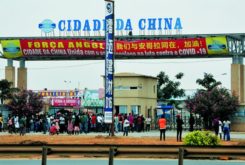The government of Angola raised US$16.7 million from the auction of diamonds, the first ever competitive auction and part of a new system to revive interest in the industry.
More than 30 companies from eight countries, including China, submitted closed online bids for seven large diamonds ranging from 43 to 114 carats.
The interest generated, and prices achieved, were high. Of the total of US$16.7 million, the government will receive a cut of 7.5%—5% in royalties and 2.5% in industrial tax. The stones were all from the Lulo mine in Lunda Norte, which is operated by Australia-listed Lucapa. They sold for an average price per carat of US$33,530.
The auction was part of a new system to commercialise the diamond industry that took effect on January 31 this year. It ended the monopoly over pricing long held by Sociedade de Comercialização de Diamantes de Angola (Sodiam), the sales arm of the stateowned diamond company, Empresa Nacional de Comercialização de Diamantes de Angola (Endiama).
According to Legispalop+TL legal database, the Technical Regulation on the Marketing of Crude Diamonds, approved by Presidential Decree No. 35/19 of January 31, entered into force that same day.
This is a major attempt to relaunch Angola’s diamond industry and bring in new foreign investment to stimulate its struggling economy. The new regulation reflects a long-held demand by companies involved in exploration and production. They will now have more options in selling their products.
Endiama intends to hold at least six tenders per year, which it expects to raise the interest of international mining companies in Angola´s vast mineral potential.
In recent years, its diamond production has been steady at around 9.5 million carats, with annual revenue of around US$1.25 billion, depending on global prices. Angola is the world’s fifth largest producer and aims to become number three by 2021.
Key to achieving this is the start of mining at the Luaxe kimberlite concession (Lunda Sul); it is widely estimated to yield up to 10 million carats a year, doubling current production.
To launch Luaxe without delay and reach this historic production goal, Angola will have to continue to improve its economic environment and hope for diamond prices to recover in international markets.
The changes to the rules are part of wider efforts to improve transparency and encourage more international investment into Angola. It currently depends on an oil industry that is in decline; this is complicating economic recovery after three years of recession.
The diamond industry has welcomed the new system. For years, many companies complained that they were forced to sell to politically connected buyers at below-market rates.
In 2018, Catoca, Angola’s largest diamond mine, estimated that it had lost more than US$450 million in the previous six years, due to what it described as underpricing.
The main objectives of the new regulation of the Angolan Executive on the Mining Sector were defined by the Mining Code of 2011 and the Diamond Marketing Policy, regulated by Presidential Decree No. 175/18.
The legislation sets out a regime of classification and evaluation of diamonds and the supervision of diamond base prices by independent evaluators at the Ministry of Mineral Resources and Petroleum (MIREMPET).
A system of uniform price criterion to be applied by producers aims to prevent sub-evaluation of raw diamonds. The law sets out rules for the three sale arrangements of raw diamonds for export or to the domestic market.
The first arrangement is sale by “sights” — periodic sale sessions through long-term contracts, to fulfil the obligations of the parties in contracts for the sale of rough diamonds.
The second is sale by “spots” — sales sessions for invited and selected buyers, in which the producers and SODIAM-E.P. sell lots of their production, not linked to long-term contracts, to the buyer offering a higher price, above the base price.
The third is sale by auctions, organized by SODIAM-E.P., in which the producers sell for the best offer from bidding by interested parties part of their production not linked to long-term contracts.
The new law also sets quotas to producers to sell the annual production of rough diamonds, determined on the basis of volume and value of production — up to 60% of production to selected buyers: between 15%-20% of production to SODIAM-E.P. : and up to 20% of its production to national diamond polishers.
The future approval of a price list by the Ministry of Finance and by MIREMPET is expected to determine the prices of the services provided by SODIAM-E.P. and the National Concessionaire ENDIAMA-E.P. in gross diamond sales payable by each seller or buyer. The buyer is required to pay fees due for the issue of the Kimberley Process Certificate. (CLBrief)



